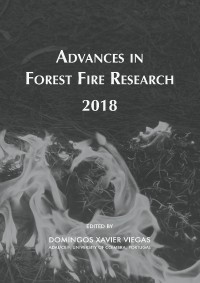Please use this identifier to cite or link to this item:
https://hdl.handle.net/10316.2/44666| DC Field | Value | Language |
|---|---|---|
| dc.contributor.author | Jimenez, Daniel | |
| dc.contributor.author | Butler, Bret | |
| dc.contributor.author | Queen, Lloyd | |
| dc.contributor.author | Hoff, Valentijn | |
| dc.contributor.author | O’Brien, Joseph | |
| dc.contributor.author | Heirs, J. Kevin | |
| dc.date.accessioned | 2018-11-11T10:35:12Z | |
| dc.date.accessioned | 2020-09-06T17:30:53Z | - |
| dc.date.available | 2018-11-11T10:35:12Z | |
| dc.date.available | 2020-09-06T17:30:53Z | - |
| dc.date.issued | 2018 | - |
| dc.identifier.isbn | 978-989-26-16-506 (PDF) | |
| dc.identifier.uri | https://hdl.handle.net/10316.2/44666 | - |
| dc.description.abstract | Fire science and management are often limited by an inability to quantitatively measure and track the properties of wildland fire at their full spatial and temporal scales (Riggan et al. 2004). Direct experimental measurements of the energy, fluid flow, and chemical processes occurring in full-scale wildland fires over a spatial extent are difficult to obtain. Techniques exist to measure the radiant intensity or emissive power of the flame; however, the high temperature and transient nature of naturally burning wildland fires has been limited to just a few localized measurements of fire intensity (Butler et al. 2004). Recent advances in unmanned aerial systems (UAS) and light weight, high resolution sensors provide an opportunity to address the various limitations associated with previous research in landscape scale fire radiative power (FRP) estimates. A series of nine small scale (0.5-1km2) field experiments were instrumented with multiple horizontal and nadir view fire behavior packages (FBPs) in order to characterize point source fire energy measurements. Additionally, in-situ and remote sensed (UAS) radiometric thermograhy data with collocated at high resolution in space and time. Coordinates of each in-situ location were acquired and pre-loaded into the UAS flight plan to ensure collocation data collects. This paper presents the experimental design and preliminary results with the intent to develop a strong correlation between highly resolved ground based fire energy measurements collacted with UAS remote sensed thermography. | eng |
| dc.language.iso | eng | - |
| dc.publisher | Imprensa da Universidade de Coimbra | por |
| dc.relation.ispartof | http://hdl.handle.net/10316.2/44517 | por |
| dc.rights | open access | - |
| dc.subject | Fire behavior | eng |
| dc.subject | thermography | eng |
| dc.subject | remote sensing | eng |
| dc.subject | unmanned aerial systems | eng |
| dc.title | A comparison of in-situ fire energy measurements to remote sensed thermography using Unmanned Aerial Systems (UAS) | por |
| dc.type | bookPart | por |
| uc.publication.firstPage | 1244 | - |
| uc.publication.lastPage | 1248 | - |
| uc.publication.location | Coimbra | por |
| dc.identifier.doi | 10.14195/978-989-26-16-506_149 | - |
| uc.publication.section | Chapter 7 - Short Contributions | por |
| uc.publication.digCollection | PB | por |
| uc.publication.orderno | 149 | - |
| uc.publication.area | Ciências da Engenharia e Tecnologias | por |
| uc.publication.bookTitle | Advances in forest fire research 2018 | - |
| uc.publication.manifest | https://dl.uc.pt/json/iiif/10316.2/44666/203807/manifest?manifest=/json/iiif/10316.2/44666/203807/manifest | - |
| uc.publication.thumbnail | https://dl.uc.pt/retrieve/11055925 | - |
| uc.publication.parentItemId | 55072 | - |
| uc.itemId | 68746 | - |
| item.fulltext | With Fulltext | - |
| item.grantfulltext | open | - |
| Appears in Collections: | Advances in forest fire research 2018 | |
Files in This Item:
| File | Description | Size | Format | |
|---|---|---|---|---|
| a_comparison_of_in-situ_fire_energy_measurements.pdf | 1.09 MB | Adobe PDF |  |
Items in DSpace are protected by copyright, with all rights reserved, unless otherwise indicated.
